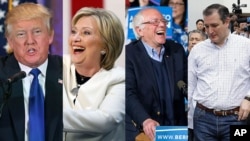The last batch of U.S. states do not hold their presidential primaries until early June, but the nominating contests are about half over.
After Tuesday's events in Michigan, Mississippi, Idaho and Hawaii, 23 of the 50 states have made their choice for the Republican nominee and 21 in the Democratic race.
An especially important group of five states hold their votes next Tuesday, March 15.
US Presidential Candidate Delegate Count
Delegate Count
Here is an estimated delegate count for each candidate:
Republicans
Donald Trump: 621
Ted Cruz: 396
John Kasich: 138
Democrats
Hillary Clinton: 1,561
Bernie Sanders: 800
Total delegates needed for party nomination:
Democrats: 2,383
Republicans: 1,237
* As of March 16, 2016
The Republican winner that day in Florida gets all of its 99 delegates, while Ohio's winner gets all of its 66, and most of the 69 delegates in Illinois go to the victor there as well.
Florida Senator Marco Rubio's campaign has been clinging to the prospect of getting a boost from his home state, but with his continued string of bad performances, even that could be too little, too late. The same goes for Ohio Governor John Kasich in his state.
Businessman Donald Trump had 458 delegates after Tuesday compared to Texas Senator Ted Cruz, who trails in second place with 359. Their goal is to amass 1,237 to claim a majority and the Republican nomination.
The Democrats have been down to a two-candidate race for more than a month with former Secretary of State Hillary Clinton leading Vermont Senator Bernie Sanders in the delegate count.
Clinton, with 1,221 delegates after Tuesday's elections, has a little more than half of the 2,383 needed to be the Democratic nominee, while Sanders is roughly one-quarter of the way there, with 571.
Clinton leads Sanders among likely Florida Democratic primary voters 62 to 32 percent, according to a Quinnipiac University poll released Wednesday. Her lead is especially strong among female voters, with 69 percent saying they would support her over Sanders' 24 percent.
Clinton's lead is smaller heading into the other major primary contest in Ohio, where she leads Sanders 52 to 43 percent among likely Democratic voters. The survey found small amounts of undecided voters in each state, suggesting those numbers would remain steady for Tuesday's vote.
For Sanders, there is no big candidate payday available. In state contests, Democrats receive a proportion of delegates based on the vote, so to make up ground he not only needs to win states, but also win them by a large margin.
Nominating conventions
The party nominees will not be made official until the Republicans and Democrats hold their conventions -- the Republicans in Cleveland July 18-21, and the Democrats in Philadelphia July 25-28.
In many election years, the winner clinches the nomination before all the states have voted.
By this point in 2008, Republican John McCain had already secured the nomination. In 2000, victories in several March 15 primaries assured both Republican George W. Bush and Democrat Al Gore of their party nominations.
This year, there are only a few state contests after March 15. Things get busy again with the April 19 primaries in delegate-rich New York and again a week later as candidates compete in five states on the same day.










